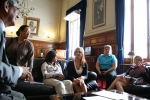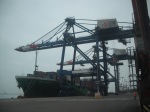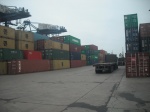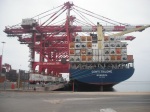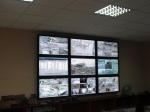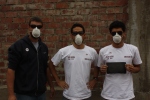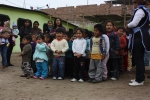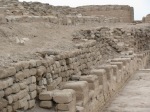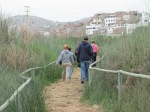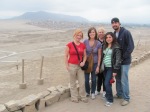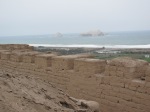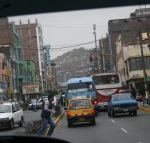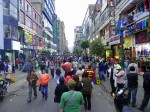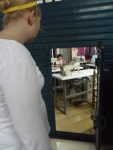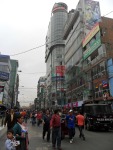By Clare Maakestad and Sanjuanita Murguia
When we walked into the Palacio Legislativo, we were greeted with an obnoxiously loud bell ringing to alert the congressmen and women that the session was starting, so they could know to head into the assembly. Dr. Celle’s pal Beatriz de Criado , who works in the congress, greeted us shortly after our arrival and introduced us to our tour guide, a sweet young woman named Juliana. She took us out to a beautiful courtyard, adorned with colorful flowers and bright grasses, and which featured a bronze statue of José Faustino Sánchez Carrión, better known by his pen-name of “El Solitario de Sayán” (The Lone Man of Sayan). He moved to the area of Sayán in northern Peru and wrote letters back to Lima criticizing the government, as he was a revolutionary in favor of independence from Spain. He is celebrated and immortalized there due to his revolutionary thoughts and ideas which helped to spur the independence movement.
From the gardens, we moved into a room that contained an enormous painting of the first constitutional congress and a painting of the president of the first constitutional congress, as well as an exhibit of pictures of a congress of indigenous people. Interestingly, our tour guide never touched on or explained the exhibit, but spent several minutes describing the large painting. We then moved into the Hall de los Pasos Perdidos (The Hall of the Lost Steps), which is where we entered the congress building. Each side of the hall is decorated with bronze busts of the presidents of each of Peru’s twelve constitutional congresses, and the floor is an ornate mosaic design, which took nine years to produce due to its intricacies.
Then, one of Lima’s congressmen, Congressman Castro, greeted us and granted us access to the press booth in the temporary assembly room where the members of congress were voting on a bill. No United States citizens have probably been granted access to the assembly since the 1990s, when Lori Berenson, an American activist with the Peruvian terrorist group MRTA (Túpac Amaru Revolutionary Movement), was found to have floor plans of the congress building to be used in a terrorist plot to bomb it. We have no idea what strings were pulled in order to let us into the assembly room, or if tensions have simply died down. However, it was a unique opportunity to see the inner workings of Peruvian government.
The other unique opportunity that we had was meeting with Congressman Jorge Rafael Foinguinos Mera, the president of the Commission of Foreign Commerce and Tourism. We met with this particular representative because Peru and the U.S. have recently entered into a free trade agreement (TLC in Spanish). He shared with us a bit about what the agreement entailed, and we were able to ask a few questions which he gladly answered. After he discussed some legal barriers blocking Peru from entering into free trade with the U.S., he described how it would benefit Peru’s economy (in particular Peru’s organic agricultural economy), considering that when it is summer in Peru, it is winter in the U.S.; so the two countries can trade food staples that are not being produced during a given season at home. We asked if this would help not only the big-time business corporate, but also the primary farmer/producer. He affirmed that entering into free trade with the U.S. would benefit all farmers including the small organic farmers, given the demand for organic products in the U.S. In addition, besides Peru’s rich variety in agricultural exports thanks to the diversity in climate and ecology, it also has a great advantage over many competing countries like Chile and Argentina, since it is closer to the equator which allows there to be faster and more plentiful growing seasons. We felt very pleased and fortunate to have had this distinct opportunity to meet with this gentleman and discuss such an important topic to U.S.-Peruvian relations.
Following our privileged 30 minute interview with Congressman Jorge Rafael Foinguinos Mera, we finished our tour of a few smaller but equally impressive rooms. With the ringing bell behind us, we left congress with not only a better understanding of Peruvian government and its history, but also with higher hopes for its economy and national well-being as it begins its new government chapter under this new president, Ollanta Humala.




